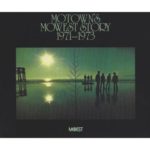
Our Lives are Shaped by What We Love: Motown’s MoWest Story 1971-1973 (Light in the Attic)
True Soul: Deep Sounds from the Left of Stax Vol. 1 and Vol. 2 (Now-Again)
Two of the great lost imprints of American soul music finally get their collective moment in the sun thanks to a pair of enjoyable and informative anthologies that shed light on the dynamic diversity of their respective catalogs.
True Soul: Deep Sounds from the Left of Stax is a two volume CD/DVD set chronicling the existence of True Soul Records, an Arkansas-based indie label run by Lee Anthony, a lifelong music biz cat who apprenticed for Sun Records’ Sam Phillips, Stax founder Al Bell and Hi Records guru Willie Mitchell and defied the region’s segregationist sentiments as one of the region’s first black entrepreneurs of the post-Jim Crow South. Unless you are a serious scholar of the funk 45 a la DJ Shadow or Cut Chemist, who have woven in more than one rare True Soul side into their legendary Brain Freeze mixes, chances are you might not recognize many of the names on the track list for these two sets. But that’s not to say this anthology is not loaded with some of the nicest rare groove shit dug up from the dirt and mold of somebody’s basement, be it Thomas East, the man behind True Soul’s biggest hit in “Funky Music,” Larry “Totsy” Davis, whose “Texas Flood” Stevie Ray Vaughan made his own for his 1983 debut LP of the same name, or The Conspiracy, members of which would go on to become the world famous Gap Band. Both halves of True Soul: Deep Sounds from the Left of Stax come housed in hardbound book style packaging, graced by an extensive interview with Anthony in the liner notes conducted by Now-Again label chief Egon and, featured on the DVD, performances from the imprint’s short-lived television program, the True Soul Revue.
Meanwhile, way out West, Motown honcho Berry Gordy was looking to branch out his venerated R&B label beyond its original location at 2648 West Grand Boulevard in Detroit, Michigan, back in 1971. And for two productive years, he ran game off the California coast with the MoWest label, a short-lived imprint that aimed to change the formula of the Motown sound in an effort to expand its sonic scope. But while it came and went quicker than you can say “makes me wanna holler,” MoWest left an impressive legacy of adventurousness that is finally chronicled on Our Lives Are Shaped By What We Love: Motown’s MoWest Story 1971-1973. While Hitsville U.S.A. was spearheading a new era of soul music with such innovative, socially charged masterpieces as Marvin Gaye’s What’s Goin’ On and Stevie Wonder’s Talking Book, MoWest was quietly staging a revolution of its own accord. This collection shows the label delving into unchartered territory for Gordy, pioneering the early strains of disco with the likes of Syretta and The Nu Page (featuring Marilyn McLeod, the sister of Alice Coltrane, on vocals), experimenting with acid folk via Lodi, the New Jersey-based offshoot of Nuggets stars The Knickerbockers, rebranding Frankie Valli and the Four Seasons as a psychedelic act and veering into Mizell Brothers territory with the Blue Note funk-flavored outfit Odyssey. All of these lost treasures, along with early turns from such future 70s superstars as Thelma Houston and The Commodores, comprise this excellent overview of MoWest’s small but imperative footprint on the recording industry. The sole holdout that was omitted from the mix was the imprint’s sole Billboard hit, Tom Clay’s schmaltzy Me Decade medley of Dick Holler’s “Abraham, Martin and John” and Burt Bacharach and Hal David’s “What the World Needs Now is Love”; and rightfully so, as it might have seemed a little off-kilter given the heady gravity of the material presented here.
Anybody looking to further their education on vintage soul music on a graduate level should definitely give both of these expert anthologies from the storage unit of pop history serious consideration for investment.



No Comments comments associated with this post